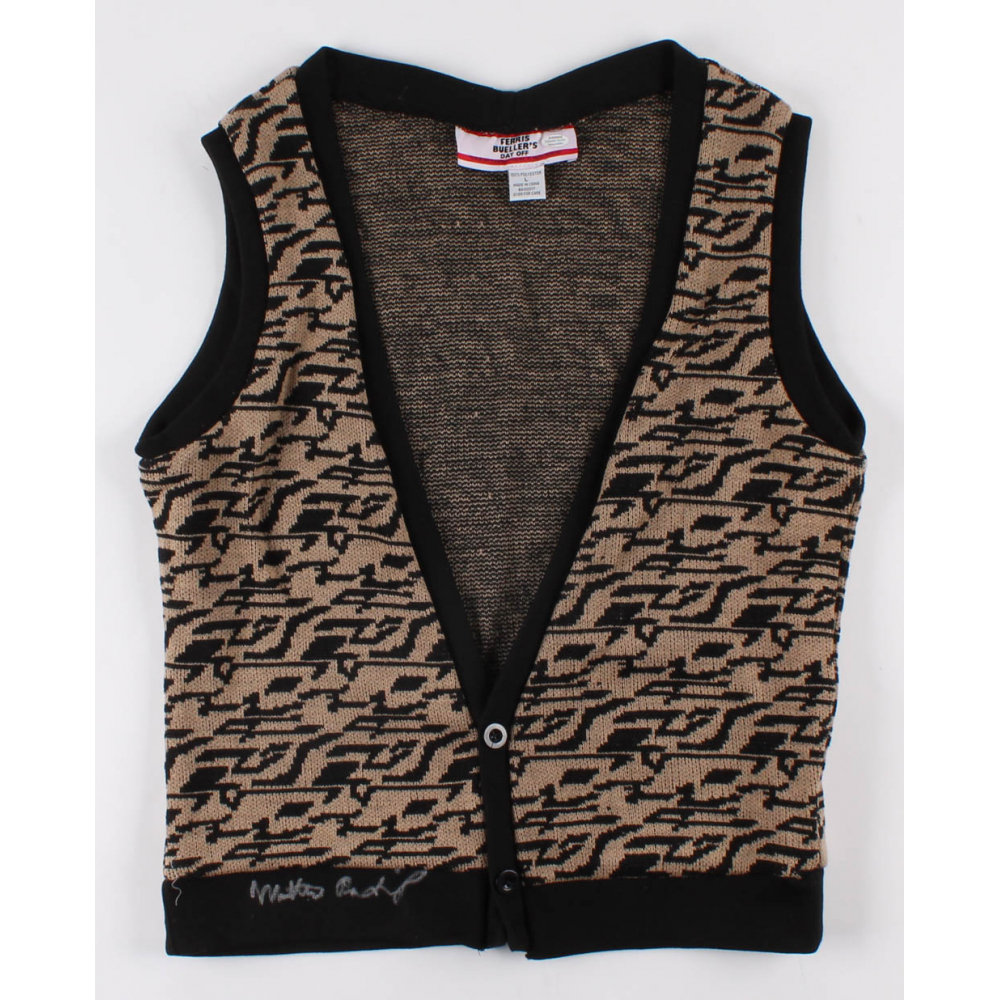When John Hughes released Ferris Bueller’s Day Off in 1986, he likely didn’t foresee that his charming teen hero’s wardrobe would one day command the price of a New York apartment. But nostalgia has its own unpredictable valuation, and this week, one of the most iconic pieces from the film—Ferris’s patterned sweater vest—fetched a staggering $279,400 at Sotheby’s in New York. After 11 intense bids, the vest, which could have been plucked from a suburban department store for mere dollars in the ’80s, ascended to the rarified status of museum-grade memorabilia.
The hammer price, roughly equivalent to the median cost of a house in certain American cities, is emblematic not just of the value of cinematic artifacts but of the larger cultural undercurrent gripping our collective memory: a fervent, almost devotional nostalgia for the 1980s.
Ferris Bueller and the mythology of youth
To understand why a single piece of clothing could fetch nearly $300,000, we must revisit the mythic nature of Ferris Bueller’s Day Off. The film is more than just a teen comedy; it’s an aspirational manifesto on seizing the day, performed with such infectious charisma by Matthew Broderick that it became a generational anthem.
In literature, there have always been characters who embody youthful rebellion and joyful defiance—Huck Finn on the Mississippi River, Holden Caulfield roaming New York. Ferris Bueller is their cinematic heir: a suburban trickster-hero orchestrating the perfect day of truancy, using Chicago as his personal playground.
John Hughes’ knack for merging slapstick humor with genuine emotional resonance solidified Ferris as a cultural icon. His striped sweater vest, casually layered over a white t-shirt, crystallized this spirit visually: casual, quirky, irreverent, and distinctly ’80s.
Clothing as cultural code
Fashion scholars have long argued that clothing is a language—a non-verbal syntax of identity, desire, and affiliation. In the case of Ferris, his sweater vest functioned as a kind of costume armor, signifying his playful audacity. Unlike Cameron Frye’s Red Wings hockey jersey or Sloane Peterson’s chic white fringe jacket, Ferris’s vest straddled the line between the youthful and the grown-up, the flamboyant and the understated.
This subtle duality resonates deeply in a contemporary world obsessed with “quiet luxury” and normcore—a cyclical aesthetic movement in which mundane, even dorky pieces become cool precisely because of their blandness. In this sense, Ferris’s vest is a harbinger of the anti-fashion fashion trends that would later dominate streetwear and high fashion alike.
Sotheby’s and the cinema collectibles market
Sotheby’s auction of Ferris’s vest is not an isolated event but part of a larger trend in the world of collectibles. Over the past decade, film memorabilia has skyrocketed in value. Marilyn Monroe’s “Subway Dress” sold for $4.6 million in 2011, Dorothy’s ruby slippers from The Wizard of Oz for $2 million, and Indiana Jones’s fedora for $500,000.
What distinguishes Ferris’s vest is its accessibility in the public imagination. While few have watched Some Like It Hot on repeat or can recite Wizard of Oz lines verbatim, almost everyone of a certain generation can recall Ferris’s day off. The sweater vest is not just an artifact; it is a portal back to a specific ethos: carefree suburban days, skipping school without consequences, and the romantic ideal of teenage freedom.
The economics of nostalgia
Psychologists and cultural historians suggest that nostalgia spikes during periods of societal uncertainty. Whether it’s economic instability, technological acceleration, or global pandemics, people reach backward in time for emotional security. This might explain why the 1980s, in particular, have been a source of recent fascination—from Stranger Thingsto reboots of classic franchises and fashion revivals at Prada and Balenciaga.
The Sotheby’s auction can be seen as both a symptom and a symbol of this collective longing. Wealthy bidders don’t just want to own an object; they want to possess a piece of a simpler narrative where the biggest problem was whether Principal Rooney would catch you skipping class.
The vest as postmodern relic
In the context of contemporary art and postmodern theory, Ferris’s vest transcends mere cloth and thread. It becomes what philosopher Jean Baudrillard would call a simulacrum—a copy without an original, a hyperreal object more real than reality itself.
Owning the vest isn’t merely about material possession; it’s about aligning oneself with an idea, a feeling, a mythos. The sweater vest is not valuable because of the fabric or the stitching. It is valuable because it stands as a totem of the irrepressible teenage spirit and the cinematic legacy of John Hughes.
Literature, youth, and timeless rebellion
Rebellion, especially in youth, has always been a dominant motif in literature and film. From Goethe’s The Sorrows of Young Werther to J.D. Salinger’s The Catcher in the Rye, literature has enshrined the youthful urge to defy authority. Ferris Bueller’s “day off” is simply a sunny, suburban, 1980s reinterpretation of this age-old impulse.
The vest becomes an extension of this literary heritage—a wearable declaration of nonconformity, stitched not in ink but in yarn. Through Ferris, Hughes crafts an archetype of joyful subversion that is as literary as it is cinematic.
The afterlife of iconic costumes
Costumes have long outlived their wearers, gaining meanings their creators never anticipated. Think of Audrey Hepburn’s black dress in Breakfast at Tiffany’s or James Dean’s red jacket in Rebel Without a Cause. These garments, preserved in museum vitrines or private collections, become metonyms for entire eras and emotional landscapes.
Ferris’s vest now joins this hallowed wardrobe. Its sale at Sotheby’s transforms it into an artifact that invites both reverence and scrutiny. Will it be displayed in a museum, or will it disappear into a private collector’s vault? Either way, it now carries the heavy weight of cultural memory.
Fashion cycles and 80s revival
The 1980s are enjoying a robust renaissance in the fashion world. Designers like Demna at Balenciaga and Jonathan Anderson at Loewe have mined the decade’s silhouettes, colors, and irreverence for new collections. Even streetwear giants have tapped into ’80s iconography, producing chunky sneakers, high-waist acid-wash jeans, and yes—sweater vests.
Ferris’s vest, in this context, isn’t just a collector’s item but an emblem of a wider cyclical fashion phenomenon. It demonstrates how a single piece can leap from screen to street to Sotheby’s, creating ripples across decades and disciplines.
The question of value
Why $279,400? Beyond pure nostalgia, such a price reflects the power of storytelling. The vest embodies the carefree, audacious spirit of Ferris Bueller, and through it, buyers seek a tangible connection to an intangible feeling. This dynamic is mirrored in the art market, where a Rothko canvas sells not merely for color fields but for the contemplative silence they evoke.
In essence, the price tag is less about the object and more about the emotional ROI—return on imagination. The buyer didn’t just acquire a vest; they acquired a totem of 1980s optimism, a physical slice of cinematic magic.
What’s next for Ferris?
With this record-setting sale, one wonders what other Ferris Bueller relics might surface. Could we see the infamous Ferrari 250 GT California replica fetch a fortune? Or perhaps the “Save Ferris” water tower sign? Each artifact holds the potential to elicit equally fervent bidding wars, driven by the same potent cocktail of nostalgia, cultural capital, and collector’s mania.
Flow
Ferris Bueller once said, “Life moves pretty fast. If you don’t stop and look around once in a while, you could miss it.” This ethos reverberates through the very fabric of his sweater vest. In an age dominated by fast-moving digital trends and ephemeral virality, this woolen relic urges us to pause, look back, and cherish the stories that shaped us.
The $279,400 vest is more than a high-priced curiosity—it is a monument to a fictional day that felt more real than any actual school day. A day where the sun shone brighter, Chicago felt like a personal playground, and a teenager reminded us all of the fleeting joy of youthful rebellion.
In the end, this auction is not merely a transaction between seller and buyer. It is a cultural exchange between past and present, a shared wink across decades. The vest will remain an enduring symbol, not just of Ferris Bueller’s perfect day off, but of our enduring quest to relive the moments when we too felt infinite and invincible.
No comments yet.








